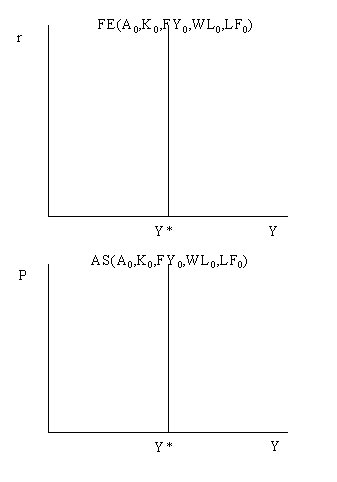
Reading: AB, chapter 9 (all) and chapter 11 (all)
Last updated on February 22, 1997.
Assumptions
| Variable behavior | Consistent with observed data? |
| Output (Y) is procyclical | Yes |
| Employment (N) is procyclical | Yes |
| Avg. labor productivity (Y/N) is procyclical | Yes |
| Real wage (W/P) is procyclical | Yes - but RBC predicts more variable W/P. The labor supply curve is too steep to be consistent with RBC predictions. |
| Prices (P) and inflation are counter-cyclical | No - P and inflation appear to be procyclical except for the oil crisis recessions. |
| Unemployment, u, is always at the natural rate u*. Changes in u represent changes in u*. | Not really - hard to justify relatively large changes in u. |
| Monetary policy is neutral | No - money appears to lead the business cycle. |
| Government spending (G) is procyclical | Yes - if we assume that increases in G make workers poorer. |

The aggregate supply (AS) curve is derived from the full
employment (FE) curve. The AS curve is plotted in a graph with
the aggregate price level on the vertical axis and output on the
horizontal axis. Recall, the aggregate supply of output is
determined by the interaction between the production function and
the labor market as summarized by the FE line. In labor market
equilibrium, full employment output is Y*. Only changes in the
production function or changes in labor demand or labor supply
will change Y*. Since the production function and the labor
market are not affected by changes in the aggregate price level
(it is assumed that any change in P is offset by changes in
nominal wages, W, so that the real wage, W/P, stays constant) the
aggregate supply curve is a vertical line in the graph with P on
the vertical axis and Y on the horizontal axis.
 The aggregate demand for goods and
services is determined at the intersection of the IS and LM
curves independent of the aggregate supply of goods and services
(implicitly, when deriving the AD curve it is assumed that
whatever is demanded can be supplied by the economy). The AD
curve is a plot of the demand for goods as the general price
level varies. For a given price level, P0, the IS and
LM curves intersect at the point (r0, Yd0).
This intersection point is plotted in the graph below (as the big
black dot). If the price level increases to P1 then
the LM curve shift up and left and the new equilibrium is at the
point (r1, Yd1). The higher real
interest rate has decreased the aggregate demand for goods. This
new equilibrium is represented as the big blue dot on the AD
curve. Similarly, if the price level drops from P0 to
P2 then the LM curve shifts down and right lowering
the real interest rate and increasing demand. This new
equilibrium is given by the big red dot on the AD curve.
The aggregate demand for goods and
services is determined at the intersection of the IS and LM
curves independent of the aggregate supply of goods and services
(implicitly, when deriving the AD curve it is assumed that
whatever is demanded can be supplied by the economy). The AD
curve is a plot of the demand for goods as the general price
level varies. For a given price level, P0, the IS and
LM curves intersect at the point (r0, Yd0).
This intersection point is plotted in the graph below (as the big
black dot). If the price level increases to P1 then
the LM curve shift up and left and the new equilibrium is at the
point (r1, Yd1). The higher real
interest rate has decreased the aggregate demand for goods. This
new equilibrium is represented as the big blue dot on the AD
curve. Similarly, if the price level drops from P0 to
P2 then the LM curve shifts down and right lowering
the real interest rate and increasing demand. This new
equilibrium is given by the big red dot on the AD curve.
The above graphs shows that the AD curve is a downward sloping function of the general price level. This occurs because a low price level (given a fixed money supply) lowers the real interest rate and stimulates interest sensitive demand.